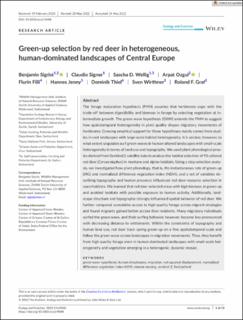Please use this identifier to cite or link to this item:
https://doi.org/10.21256/zhaw-25458| Publication type: | Article in scientific journal |
| Type of review: | Peer review (publication) |
| Title: | Green-up selection by red deer in heterogeneous, human-dominated landscapes of Central Europe |
| Authors: | Sigrist, Benjamin Signer, Claudio Wellig, Sascha D. Ozgul, Arpat Filli, Flurin Jenny, Hannes Thiel, Dominik Wirthner, Sven Graf, Roland Felix |
| et. al: | No |
| DOI: | 10.1002/ece3.9048 10.21256/zhaw-25458 |
| Published in: | Ecology and Evolution |
| Volume(Issue): | 12 |
| Issue: | 7 |
| Page(s): | e9048 |
| Issue Date: | 2022 |
| Publisher / Ed. Institution: | Wiley |
| ISSN: | 2045-7758 |
| Language: | English |
| Subjects: | Switzerland; Green wave hypothesis; Human disturbance; Migration; Net squared displacement; Normalized difference vegetation index NDVI; Remote sensing; Sentinel 2 |
| Subject (DDC): | 333.7: Land, natural recreational areas 590: Animals (Zoology) |
| Abstract: | The forage maturation hypothesis (FMH) assumes that herbivores cope with the trade-off between digestibility and biomass in forage by selecting vegetation at intermediate growth. The green wave hypothesis (GWH) extends the FMH to suggest how spatiotemporal heterogeneity in plant quality shapes migratory movements of herbivores. Growing empirical support for these hypotheses mainly comes from studies in vast landscapes with large-scale habitat heterogeneity. It is unclear, however, to what extent ungulates surf green waves in human-altered landscapes with small-scale heterogeneity in terms of land use and topography. We used plant phenological proxies derived from Sentinel 2 satellite data to analyze the habitat selection of 93 collared red deer (Cervus elaphus) in montane and alpine habitats. Using a step selection analysis, we investigated how plant phenology, that is, the instantaneous rate of green-up (IRG) and normalized difference vegetation index (NDVI), and a set of variables describing topography and human presence influenced red deer resource selection in open habitats. We learned that red deer selected areas with high biomass at green-up and avoided habitats with possible exposure to human activity. Additionally, landscape structure and topography strongly influenced spatial behavior of red deer. We further compared cumulative access to high-quality forage across migrant strategies and found migrants gained better access than residents. Many migratory individuals surfed the green wave, and their surfing behavior, however, became less pronounced with decreasing distance to settlements. Within the constraints of topography and human land use, red deer track spring green-up on a fine spatiotemporal scale and follow the green wave across landscapes in migration movements. Thus, they benefit from high-quality forage even in human-dominated landscapes with small-scale heterogeneity and vegetation emerging in a heterogenic, dynamic mosaic. |
| URI: | https://digitalcollection.zhaw.ch/handle/11475/25458 |
| Fulltext version: | Published version |
| License (according to publishing contract): | CC BY 4.0: Attribution 4.0 International |
| Departement: | Life Sciences and Facility Management |
| Organisational Unit: | Institute of Natural Resource Sciences (IUNR) |
| Appears in collections: | Publikationen Life Sciences und Facility Management |
Files in This Item:
| File | Description | Size | Format | |
|---|---|---|---|---|
| 2022_Sigrist-etal_Green‐up-selection-by-red-deer-Central-Europe.pdf | 4.91 MB | Adobe PDF |  View/Open |
Show full item record
Sigrist, B., Signer, C., Wellig, S. D., Ozgul, A., Filli, F., Jenny, H., Thiel, D., Wirthner, S., & Graf, R. F. (2022). Green-up selection by red deer in heterogeneous, human-dominated landscapes of Central Europe. Ecology and Evolution, 12(7), e9048. https://doi.org/10.1002/ece3.9048
Sigrist, B. et al. (2022) ‘Green-up selection by red deer in heterogeneous, human-dominated landscapes of Central Europe’, Ecology and Evolution, 12(7), p. e9048. Available at: https://doi.org/10.1002/ece3.9048.
B. Sigrist et al., “Green-up selection by red deer in heterogeneous, human-dominated landscapes of Central Europe,” Ecology and Evolution, vol. 12, no. 7, p. e9048, 2022, doi: 10.1002/ece3.9048.
SIGRIST, Benjamin, Claudio SIGNER, Sascha D. WELLIG, Arpat OZGUL, Flurin FILLI, Hannes JENNY, Dominik THIEL, Sven WIRTHNER und Roland Felix GRAF, 2022. Green-up selection by red deer in heterogeneous, human-dominated landscapes of Central Europe. Ecology and Evolution. 2022. Bd. 12, Nr. 7, S. e9048. DOI 10.1002/ece3.9048
Sigrist, Benjamin, Claudio Signer, Sascha D. Wellig, Arpat Ozgul, Flurin Filli, Hannes Jenny, Dominik Thiel, Sven Wirthner, and Roland Felix Graf. 2022. “Green-up Selection by Red Deer in Heterogeneous, Human-Dominated Landscapes of Central Europe.” Ecology and Evolution 12 (7): e9048. https://doi.org/10.1002/ece3.9048.
Sigrist, Benjamin, et al. “Green-up Selection by Red Deer in Heterogeneous, Human-Dominated Landscapes of Central Europe.” Ecology and Evolution, vol. 12, no. 7, 2022, p. e9048, https://doi.org/10.1002/ece3.9048.
Items in DSpace are protected by copyright, with all rights reserved, unless otherwise indicated.